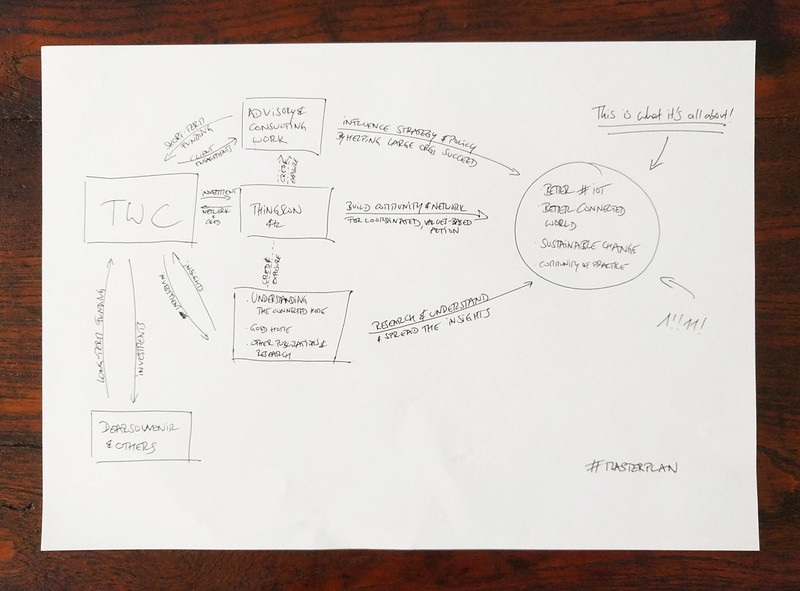Often—nay: usually—the outside world has an incomplete picture of what’s going on inside another organization. What’s happening, and why is it happening? How does this bit relate to that? This holds especially true in organizations that do a lot out of sight (like confidential work) as well as exploratory work (ie. uncharted territories, testing new things and models at a higher pace).
I relate to this, a lot, in my day-to-day work through The Waving Cat (TWC) because:
- TWC is an organization that as mentioned above that does a lot of work out of sight (because confidential) as well as exploratory &
- TWC is a one-person company, fully held by me; it is in some ways an administrative backend to allow me to make decisions and explore areas that in larger context would be much harder to justify but that I deem important and relevant. Often, that means using various labels, working through quite a few collaborations, and wearing a great number of hats.
It can be a bit confusing and hard to understand from the outside what’s happening and why—especially since there are always parts that are largely invisible, and others that are highly visible but hardly representative of the core of the work and vision at TWC.
**
I recently read Elon Musk’s Masterplan Part Deux for Tesla. Forget about the concrete content for now; for the purpose of this blog post it is almost entirely irrelevant, it’s just a reminder of why masterplans are helpful. This is about structure, organization, accessibility, communications.
This master plan, part two, serves to explain where the company is coming from (history), where it’s headed (vision), and how they want to get from one to the other (strategy). It also refers back to a first master plan of 10 years earlier, to give a point of reference, and some background of what worked (or not) and what has changed since.

In other words, it’s a map. Maps are terribly helpful things. A map can make all the difference between seeing lots of dots and making sense of them (and of others that might be out of sight). So let’s draw a map.
**
I’ve always blogged very openly about the things I do, and why I do them. (There are too many posts about this to pick one and link to, but if you dig through the archives you’ll find plenty over the last ten years, since way before the company itself existed.) But I noticed I only ever hinted at any masterplan-ish map even though of course it has existed to some degree all along.
So over the weekend I set down and sketched it out. It’s a work in progress, as always, but I think it fairly well represents how the many dots TWC is involved in connect and form a larger picture.

The overall goal is to make sure that as the world gets increasingly connected, it gets better. Positive social change through a community of practice, through better use of emerging technology, and by shaping this technology’s development and implementation.
I’m working from a few assumptions and through several major strands of activity. My assumptions are roughly these:
- We can positively shape technologies, the role of technology, and by extension the future.
- Good values mean good business. Leaning towards openness, collaboration, transparency, respect, sustainability, and a multi-stakeholder approach leads to more and better opportunities for all parties involved.
- Favor value creation over value extraction. The best businesses aren’t built around value extraction and zero-sum games but on positive-sum games, in other words by creating value for all parties.
- Values-based, networked action is a powerful driver of change. There is not a single point at which to push for change, but rather many points at all touch points of an organization (strategy, product, policy, design, development, research, etc.). Practitioners have autonomy and discretion in their daily work to push for better outcomes.
Future-proofing an organization isn’t a goal in itself but a result of a process based on the assumptions mentioned above.
To work towards the goal outlined above, I follow three major strands—as much through collaborative means as possible—including:
- Client work: Straight-up advisory and consulting engagement. This provides opportunity to influence strategy and policy with a significant leverage by helping large organizations succeed and reach their goals. It also provides the short and mid term funding for the company.
- ThingsCon and its various related activities: This serves to build a community and network for coordinated, values-based action. This is an investment of time and money; it pays through a stronger network as well as cred (which in turn fuels client work).
- Publications & other explorations, like our ebook Understanding the Connected Home as well as Good Home and other research projects. These are research avenues and help me both understand more about the research topics (read: I gain insights) and spread them, advancing the overall company mission. Those are investments in time and money, and pay back in priceless insights. They also bring some more cred and exposure that pay forward into both ThingsCon and client engagement contexts.
- Investments: A fourth dedicated bit is longer-term investments and spin-offs. Dearsouvenir is the first of those, which means a major transition phase for TWC. It’s a lovely, ambitious, smart team and a fantastic product that I’m proud and glad to play an active role in. There might be others. This helps spread the portfolio, explore some new niches, and also helps secure a more diverse revenue stream in the long run.
**
I truly believe (and you’ll find this referenced in the ThingsCon mission statement explicitly) that we can shape emerging tech for positive change, one product or policy at a time. This is what long-term, TWC is all about. It’s what I’ve been working towards for years, in all I’ve been doing. It’s what I plan to keep doing going forward, too.
So let’s get right back on it.


